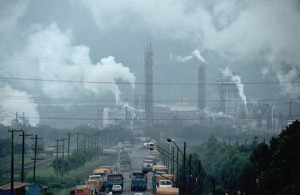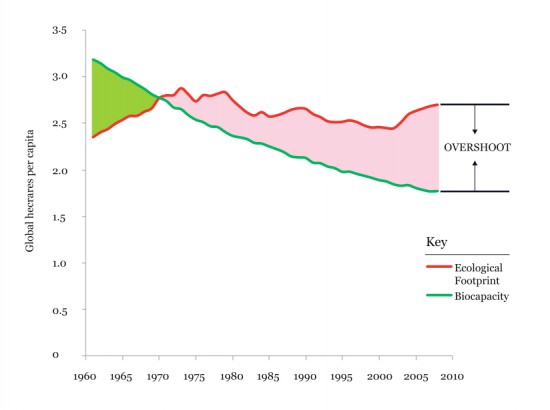Report: Humanity Has Overshot The Earth's Biocapacity
 A new report on China’s ecological footprint opens with some grim news for the planet as a whole: The demand humans place on the planet — in terms of land use, resource consumption, pollution, and so on — overshot the Earth’s threshold for sustaining that demand back in the early 1970s. Since then the gap has only grown wider.
A new report on China’s ecological footprint opens with some grim news for the planet as a whole: The demand humans place on the planet — in terms of land use, resource consumption, pollution, and so on — overshot the Earth’s threshold for sustaining that demand back in the early 1970s. Since then the gap has only grown wider.The report measures that demand by “ecological footprint,” which takes into account the area people use to produce the renewable resources they consume, the area that’s taken up by infrastructure, and the area of forest needed to absorb CO2 emissions not absorbed by the ocean. The report then compared that to the Earth’s biocapacity, which measures the amount of area available to serve all those purposes.
Both factors are measured in units of global hectares (gha), which represent “the productive capacity of one hectare area of utilized land at global average biological productivity levels.” And as it turns out, humanity’s footprint now outpaces the planet’s total biocapacity to the point that it would take one and a half Earths to sustain our total level of consumption:
In 2008, the Earth’s total biocapacity was 12.0 billion gha, or 1.8 gha per person, while humanity’s Ecological Footprint was 18.2 billion gha, or 2.7 gha per person. This discrepancy means it would take 1.5 years for the Earth to fully regenerate the renewable resources that people used in one year, or in other words, we used the equivalent of 1.5 Earths to support our consumption.
Just as it is possible to withdraw money from a bank account more quickly than the interest that accrues, biocapacity can be reused more quickly than it regenerates. Eventually the resources – our natural capital, will be depleted just like running down reserves in a bank account. At present, people are often able to shift their sourcing when faced with local resource limitations. However, if consumption continues to increase as it has in the past decades, the planet as a whole will eventually run out of resources. Some ecosystems will collapse and cease to be productive even before the resource is fully depleted.

Between 1961 and 2008, population growth drove much of the increase in humanity’s global ecological footprint. But growth in footprint per capita was also a significant contributor to the rise, particularly in the developed western nations of the OECD and the up-and-coming countries of Brazil, Russia, India and China. Even though its population is significantly smaller, America’s per capita footprint far exceeds that of China, and actually ranked 6th out of 150 countries measured in the report. And as the report’s description suggests, the per capita footprint is amenable to reform: Shifting to renewable energy, upgrading to energy efficient infrastructure, smart land and water use, and a host of other changes can bring down a population’s per capita footprint while also protecting and respecting its quality of life.
Smart use of energy and resources could also help close the overshoot gap from the other side as well: As the graph shows, the global ecological footprint has essentially plateaued over the last few decades, while the Earth’s biocapacity has continued to drop. Which in turn brings up the limitations of how we currently measure human economic progress — even as global gross domestic product has climbed over the last four decades, global biocapacity has been in a continuous decline.
You can return to the main Market News page, or press the Back button on your browser.

